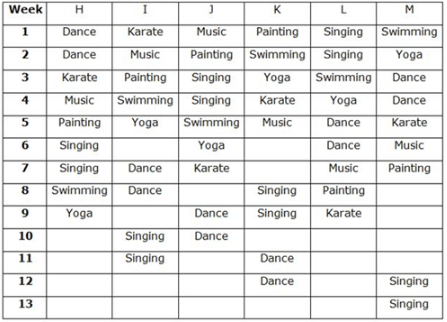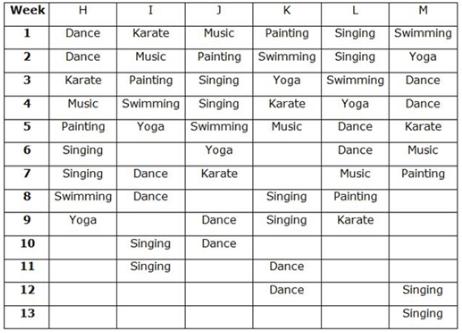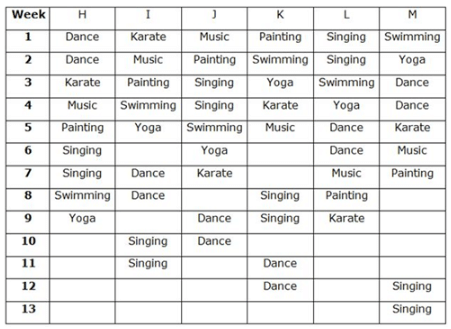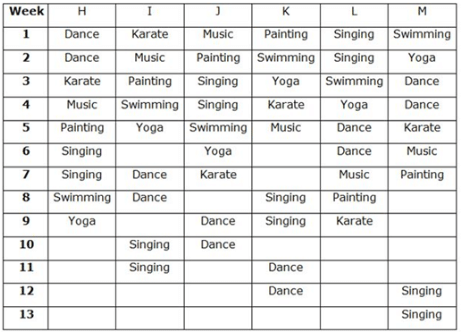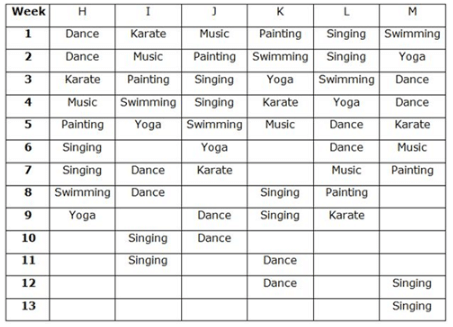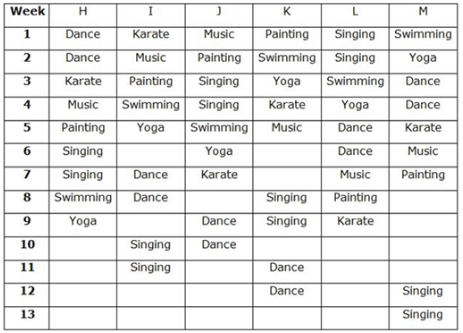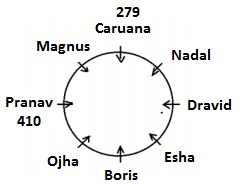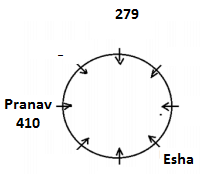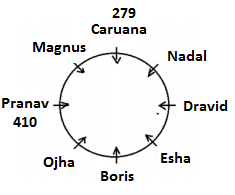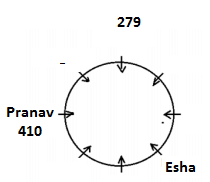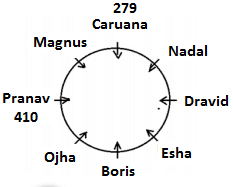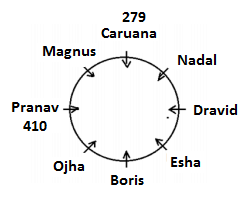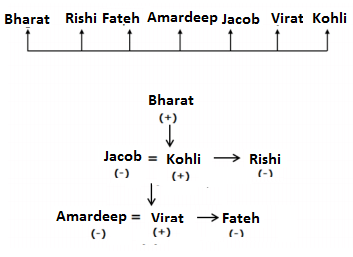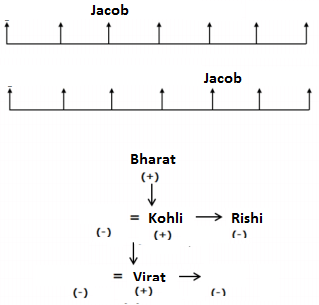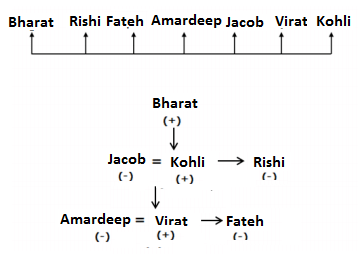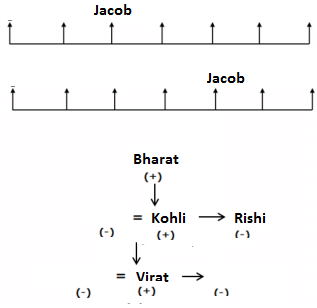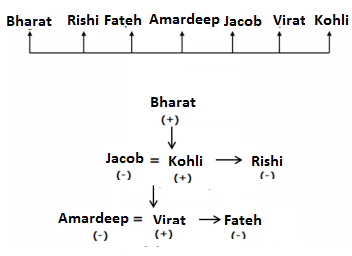SBI PO Mains Mock Test - 2 (New Pattern) - Bank Exams MCQ
30 Questions MCQ Test - SBI PO Mains Mock Test - 2 (New Pattern)
Study the following information carefully and answer the questions given below.
Six persons viz. H, I, J, K, L and M, are planning to attend seven different classes in a week viz. Painting, Music, Singing, Swimming, Karate, Yoga and Dance in alphabetical order. One can attend the Yoga class only after attending the Swimming class. The Singing and dance classes will be completed in consecutively two weeks whereas the rest are completed in one week.
In the first week, H attends the Dance class and I attend the Karate class and so on as in alphabetical order. The classes will be repeated in alphabetical order only.
Note: If a class in order is unavailable, then the next class in the series will be assigned. i.e., if the person needs to attend Karate class in alphabetical order but is already assigned to someone, then that person should be assigned with Music class.
Yoga class will be followed by Dance class and the cycle repeats. Each person attends each class only once. If for a person, no class is available for a particular week (either because he has already attended all the classes or he cannot attend the available classes or the class that he has to attend is already attended by the person who is before as in alphabetical order), then that person does not attend any class during that week.
In which of the following week did M attend the Karate class?
Study the following information carefully and answer the questions given below.
Six persons viz. H, I, J, K, L and M, are planning to attend seven different classes in a week viz. Painting, Music, Singing, Swimming, Karate, Yoga and Dance in alphabetical order. One can attend the Yoga class only after attending the Swimming class. The Singing and dance classes will be completed in consecutively two weeks whereas the rest are completed in one week.
In the first week, H attends the Dance class and I attend the Karate class and so on as in alphabetical order. The classes will be repeated in alphabetical order only.
Note: If a class in order is unavailable, then the next class in the series will be assigned. i.e., if the person needs to attend Karate class in alphabetical order but is already assigned to someone, then that person should be assigned with Music class.
Yoga class will be followed by Dance class and the cycle repeats. Each person attends each class only once. If for a person, no class is available for a particular week (either because he has already attended all the classes or he cannot attend the available classes or the class that he has to attend is already attended by the person who is before as in alphabetical order), then that person does not attend any class during that week.
Which of the following class is attended by K in week 9?
Study the following information carefully and answer the questions given below.
Six persons viz. H, I, J, K, L and M, are planning to attend seven different classes in a week viz. Painting, Music, Singing, Swimming, Karate, Yoga and Dance in alphabetical order. One can attend the Yoga class only after attending the Swimming class. The Singing and dance classes will be completed in consecutively two weeks whereas the rest are completed in one week.
In the first week, H attends the Dance class and I attend the Karate class and so on as in alphabetical order. The classes will be repeated in alphabetical order only.
Note: If a class in order is unavailable, then the next class in the series will be assigned. i.e., if the person needs to attend Karate class in alphabetical order but is already assigned to someone, then that person should be assigned with Music class.
Yoga class will be followed by Dance class and the cycle repeats. Each person attends each class only once. If for a person, no class is available for a particular week (either because he has already attended all the classes or he cannot attend the available classes or the class that he has to attend is already attended by the person who is before as in alphabetical order), then that person does not attend any class during that week.
Who among the following attends Karate class in week 7?
Study the following information carefully and answer the questions given below.
Six persons viz. H, I, J, K, L and M, are planning to attend seven different classes in a week viz. Painting, Music, Singing, Swimming, Karate, Yoga and Dance in alphabetical order. One can attend the Yoga class only after attending the Swimming class. The Singing and dance classes will be completed in consecutively two weeks whereas the rest are completed in one week.
In the first week, H attends the Dance class and I attend the Karate class and so on as in alphabetical order. The classes will be repeated in alphabetical order only.
Note: If a class in order is unavailable, then the next class in the series will be assigned. i.e., if the person needs to attend Karate class in alphabetical order but is already assigned to someone, then that person should be assigned with Music class.
Yoga class will be followed by Dance class and the cycle repeats. Each person attends each class only once. If for a person, no class is available for a particular week (either because he has already attended all the classes or he cannot attend the available classes or the class that he has to attend is already attended by the person who is before as in alphabetical order), then that person does not attend any class during that week.
How many weeks it took for all the persons to attend all the classes without fail?
(b)10
Directions: Study the following information carefully and answer the question.
Z! means the one who scores 29 more than Z sits 2nd to the right of Z.
Z$ means the one who scores 21 less than Z sits 3rd to the right of Z.
Z+ means one who scores 60 more than Z sits to the immediate left of Z.
Z* means the one who scores double the points of Z sits second to the left of Z.
There are eight students viz. Pranav, Boris, Caruana, Dravid, Esha, Magnus, Nadal and Ojha who appear in an examination and are sitting around a circular table facing the centre. They score different marks. Dravid and Magnus are not immediate neighbours. The one who scores 279 sits second to the left of Pranav, who scores 410. Esha sits third to the right of Pranav. Only one person sits between Esha and Ojha, who sits second to the right of Magnus. Boris sits third to the left of Nadal. The one who scores 279 is the immediate neighbour of Nadal.
What is the total score of Esha and Ojha if the codes are 'Esha$' and 'Ojha+'?
Directions: Study the following information carefully and answer the question.
Z! means the one who scores 29 more than Z sits 2nd to the right of Z.
Z$ means the one who scores 21 less than Z sits 3rd to the right of Z.
Z+ means one who scores 60 more than Z sits to the immediate left of Z.
Z* means the one who scores double the points of Z sits second to the left of Z.
There are eight students viz. Pranav, Boris, Caruana, Dravid, Esha, Magnus, Nadal and Ojha who appear in an examination and are sitting around a circular table facing the centre. They score different marks. Dravid and Magnus are not immediate neighbours. The one who scores 279 sits second to the left of Pranav, who scores 410. Esha sits third to the right of Pranav. Only one person sits between Esha and Ojha, who sits second to the right of Magnus. Boris sits third to the left of Nadal. The one who scores 279 is the immediate neighbour of Nadal.
Magnus scored how much percent (approximately) less/more than Nadal if the codes are 'Nadal$' and 'Magnus+'?
Directions: Study the following information carefully and answer the question.
Z! means the one who scores 29 more than Z sits 2nd to the right of Z.
Z$ means the one who scores 21 less than Z sits 3rd to the right of Z.
Z+ means one who scores 60 more than Z sits to the immediate left of Z.
Z* means the one who scores double the points of Z sits second to the left of Z.
There are eight students viz. Pranav, Boris, Caruana, Dravid, Esha, Magnus, Nadal and Ojha who appear in an examination and are sitting around a circular table facing the centre. They score different marks. Dravid and Magnus are not immediate neighbours. The one who scores 279 sits second to the left of Pranav, who scores 410. Esha sits third to the right of Pranav. Only one person sits between Esha and Ojha, who sits second to the right of Magnus. Boris sits third to the left of Nadal. The one who scores 279 is the immediate neighbour of Nadal.
What is the difference between the scores of Boris and Ojha if the codes are 'Ojha+' and 'Boris*'?
Directions: Study the following information carefully and answer the question.
Z! means the one who scores 29 more than Z sits 2nd to the right of Z.
Z$ means the one who scores 21 less than Z sits 3rd to the right of Z.
Z+ means one who scores 60 more than Z sits to the immediate left of Z.
Z* means the one who scores double the points of Z sits second to the left of Z.
There are eight students viz. Pranav, Boris, Caruana, Dravid, Esha, Magnus, Nadal and Ojha who appear in an examination and are sitting around a circular table facing the centre. They score different marks. Dravid and Magnus are not immediate neighbours. The one who scores 279 sits second to the left of Pranav, who scores 410. Esha sits third to the right of Pranav. Only one person sits between Esha and Ojha, who sits second to the right of Magnus. Boris sits third to the left of Nadal. The one who scores 279 is the immediate neighbour of Nadal.
What is the score of Dravid in the examination if the code is 'Dravid!'?
Two machine rearranges a given word and number step by step to a final output following same rule. Study the following information carefully and answer the below questions.
Machine 1:
Input: Social 372 473 Open Under 564 Network 385
Step I: _(A)__(B)__(C)__(D)__(E)__(F)__(G)__(H)_
Step II: bhknrz 654 djmnqsv 732 473 Open Under 385
Step III: _(A)__(B)__(C)__(D)__(E)__(F)__(G)__(H)_
Step IV: vsofe 374 qpof 583 bhknrz 654 djmnqsv 732
Machine 2:
Input: 381 Travel 468 Magic 624 Above Entry 531
Step I: bfhlz 648 381 Travel 624 Above Entry 531
Step II: _(A)__(B)__(C)__(D)__(E)__(F)__(G)__(H)_
Step III: wpfcb 183 dkqsuz 264 bfhlz 648 Entry 531
Step IV: _(A)__(B)__(C)__(D)__(E)__(F)__(G)__(H)_
What is the difference between the second highest number in step IV of machine 2 and the second lowest number in step III of machine 1?
Two machine rearranges a given word and number step by step to a final output following same rule. Study the following information carefully and answer the below questions.
Machine 1:
Input: Social 372 473 Open Under 564 Network 385
Step I: _(A)__(B)__(C)__(D)__(E)__(F)__(G)__(H)_
Step II: bhknrz 654 djmnqsv 732 473 Open Under 385
Step III: _(A)__(B)__(C)__(D)__(E)__(F)__(G)__(H)_
Step IV: vsofe 374 qpof 583 bhknrz 654 djmnqsv 732
Machine 2:
Input: 381 Travel 468 Magic 624 Above Entry 531
Step I: bfhlz 648 381 Travel 624 Above Entry 531
Step II: _(A)__(B)__(C)__(D)__(E)__(F)__(G)__(H)_
Step III: wpfcb 183 dkqsuz 264 bfhlz 648 Entry 531
Step IV: _(A)__(B)__(C)__(D)__(E)__(F)__(G)__(H)_
What comes in place of G in step II of machine 2?
Two machine rearranges a given word and number step by step to a final output following same rule. Study the following information carefully and answer the below questions.
Machine 1:
Input: Social 372 473 Open Under 564 Network 385
Step I: _(A)__(B)__(C)__(D)__(E)__(F)__(G)__(H)_
Step II: bhknrz 654 djmnqsv 732 473 Open Under 385
Step III: _(A)__(B)__(C)__(D)__(E)__(F)__(G)__(H)_
Step IV: vsofe 374 qpof 583 bhknrz 654 djmnqsv 732
Machine 2:
Input: 381 Travel 468 Magic 624 Above Entry 531
Step I: bfhlz 648 381 Travel 624 Above Entry 531
Step II: _(A)__(B)__(C)__(D)__(E)__(F)__(G)__(H)_
Step III: wpfcb 183 dkqsuz 264 bfhlz 648 Entry 531
Step IV: _(A)__(B)__(C)__(D)__(E)__(F)__(G)__(H)_
What comes in place of C in step IV of machine 2?
Two machine rearranges a given word and number step by step to a final output following same rule. Study the following information carefully and answer the below questions.
Machine 1:
Input: Social 372 473 Open Under 564 Network 385
Step I: _(A)__(B)__(C)__(D)__(E)__(F)__(G)__(H)_
Step II: bhknrz 654 djmnqsv 732 473 Open Under 385
Step III: _(A)__(B)__(C)__(D)__(E)__(F)__(G)__(H)_
Step IV: vsofe 374 qpof 583 bhknrz 654 djmnqsv 732
Machine 2:
Input: 381 Travel 468 Magic 624 Above Entry 531
Step I: bfhlz 648 381 Travel 624 Above Entry 531
Step II: _(A)__(B)__(C)__(D)__(E)__(F)__(G)__(H)_
Step III: wpfcb 183 dkqsuz 264 bfhlz 648 Entry 531
Step IV: _(A)__(B)__(C)__(D)__(E)__(F)__(G)__(H)_
What comes in place of B in step III of machine 1?
Directions: Read the following information carefully and answer the question that follows.
There are six friends Niraj, Sonam, Deepak, Chandan, Binod and Anil, who take one hour tuition from different institutes and go to the class at different times of the day - 1 o'clock, 2 o'clock, 3 o' clock, 4 o'clock, 5 o'clock, 6 o'clock, but not necessarily in the same order. No two students have the same timings. Anil goes for the class at 1 o'clock. There is a three-hour difference between the class timings of Anil and Binod. Deepak goes for the class two hours after Binod. Chandan goes to the class before Deepak but after Binod. Niraj goes to the class before Sonam.
Who goes to the class at 4 o'clock?
Directions: Read the following information carefully and answer the question that follows.
There are six friends Niraj, Sonam, Deepak, Chandan, Binod and Anil, who take one hour tuition from different institutes and go to the class at different times of the day - 1 o'clock, 2 o'clock, 3 o' clock, 4 o'clock, 5 o'clock, 6 o'clock, but not necessarily in the same order. No two students have the same timings. Anil goes for the class at 1 o'clock. There is a three-hour difference between the class timings of Anil and Binod. Deepak goes for the class two hours after Binod. Chandan goes to the class before Deepak but after Binod. Niraj goes to the class before Sonam.
Who goes to the class at 5 o'clock?
Directions: Read the following information carefully and answer the question that follows.
There are six friends Niraj, Sonam, Deepak, Chandan, Binod and Anil, who take one hour tuition from different institutes and go to the class at different times of the day - 1 o'clock, 2 o'clock, 3 o' clock, 4 o'clock, 5 o'clock, 6 o'clock, but not necessarily in the same order. No two students have the same timings. Anil goes for the class at 1 o'clock. There is a three-hour difference between the class timings of Anil and Binod. Deepak goes for the class two hours after Binod. Chandan goes to the class before Deepak but after Binod. Niraj goes to the class before Sonam.
Who is the last person to go to the class?
Read the given paragraph carefully. Few sentences have been given below the paragraph. These sentences would be inferences, assumptions, conclusions, causes or effects or course of action. Identify which statement falls in which category and mark your answers accordingly
Just a few hours remain for social media platforms- Facebook, WhatsApp and Twitter - to comply with the government's new Information Technology Rules, 2021. If they fail to fall in line, they risk losing 'intermediary' status. The new rules come into effect soon. Social media intermediaries were given three months to comply with India's new Information Technology (IT) rules that were notified in February. There is considerable apprehension among businesses and users regarding the potential operability of these platforms and data safety.
A. The government has mandated that the social media platforms comply with the rules
B. The Social Media Platforms risk losing their 'intermediary' status
C. The platforms will be seen as a publisher and will directly be responsible for anything published on the website
D. Giving a deadline would induce the social media platforms to comply with the norms
E. The social media platforms must issue a statement that they will make sure the data safety is not compromised
Statement A can be labeled as which of the following options given below?
Read the given paragraph carefully. Few sentences have been given below the paragraph. These sentences would be inferences, assumptions, conclusions, causes or effects or course of action. Identify which statement falls in which category and mark your answers accordingly
Just a few hours remain for social media platforms- Facebook, WhatsApp and Twitter - to comply with the government's new Information Technology Rules, 2021. If they fail to fall in line, they risk losing 'intermediary' status. The new rules come into effect soon. Social media intermediaries were given three months to comply with India's new Information Technology (IT) rules that were notified in February. There is considerable apprehension among businesses and users regarding the potential operability of these platforms and data safety.
A. The government has mandated that the social media platforms comply with the rules
B. The Social Media Platforms risk losing their 'intermediary' status
C. The platforms will be seen as a publisher and will directly be responsible for anything published on the website
D. Giving a deadline would induce the social media platforms to comply with the norms
E. The social media platforms must issue a statement that they will make sure the data safety is not compromised
Which of the following sentences can be classified as a probable effect of a certain cause mentioned in the paragraph?
Directions: Study the following information carefully and answer the question.
In a family of seven persons, Amardeep, Bharat, Fateh, Jacob, Kohli, Rishi and Virat are sitting in a row facing the north direction. Jacob sits third from the extreme end. Three persons sit between the father of Virat and Virat's sister. Virat does not have any brother. One person sits between Kohli and the mother of Virat. Kohli is the only son of Bharat. Bharat sits third to the left of Amardeep. Jacob sits second to the left of the father of Virat. Bharat is the father of Rishi. Fateh sits to the immediate right of Rishi. Virat's wife sits second to the left of Virat. As many people sit to the right of the mother of Virat as to the left of Virat's sister.
How is Kohli related to Amardeep?
Directions: Study the following information carefully and answer the question.
In a family of seven persons, Amardeep, Bharat, Fateh, Jacob, Kohli, Rishi and Virat are sitting in a row facing the north direction. Jacob sits third from the extreme end. Three persons sit between the father of Virat and Virat's sister. Virat does not have any brother. One person sits between Kohli and the mother of Virat. Kohli is the only son of Bharat. Bharat sits third to the left of Amardeep. Jacob sits second to the left of the father of Virat. Bharat is the father of Rishi. Fateh sits to the immediate right of Rishi. Virat's wife sits second to the left of Virat. As many people sit to the right of the mother of Virat as to the left of Virat's sister.
Who sits fourth to the left of Virat?
Directions: Study the following information carefully and answer the question.
In a family of seven persons, Amardeep, Bharat, Fateh, Jacob, Kohli, Rishi and Virat are sitting in a row facing the north direction. Jacob sits third from the extreme end. Three persons sit between the father of Virat and Virat's sister. Virat does not have any brother. One person sits between Kohli and the mother of Virat. Kohli is the only son of Bharat. Bharat sits third to the left of Amardeep. Jacob sits second to the left of the father of Virat. Bharat is the father of Rishi. Fateh sits to the immediate right of Rishi. Virat's wife sits second to the left of Virat. As many people sit to the right of the mother of Virat as to the left of Virat's sister.
How many persons sit to the left of Virat?
In April 2025, The Ministry of Interior of the United Arab Emirates (UAE) was recently elected to chair INTERPOL's Committee on Governance, becoming the first country to hold this position. This marks a significant step in the UAE's involvement with international law enforcement organizations. For how long will the UAE chair the INTERPOL Committee on Governance?
In April 2025, the Reserve Bank of India (RBI) extended the deadline for banks to deploy Bureau of Indian Standards (BIS)-compliant Note Sorting Machines (NSMs). What is the new deadline for banks to implement the BIS standards for note sorting?
In March 2025, Which of the following statements about C-DOT's Samarth incubation program are correct?
1. The program will support 36 startups per year in the telecom and IT sector.
2. It is implemented in partnership with Software Technology Parks of India (STPI).
3. Selected startups will receive funding up to ₹10 lakh under the program.
In May 2025, the International Football Federation (FIFA) announced that Brazil will host the Women’s World Cup in 2027. Brazil will host the Women's World Cup for the first time. Which country hosted the Women's FIFA World Cup in 2023?
In April 2025, the Ministry of Panchayati Raj (MoPR) launched the Panchayat Advancement Index(PAI) baseline report for FY23, which evaluates the performance of over 2.5 lakh Gram Panchayats (GPs). Which of the following states has been recognised as a Front Runner in the PAI baseline report for FY23?
Union Budget 2025–2026 reaffirmed the government’s commitment to digital infrastructure by extending broadband connectivity to essential rural institutions. The initiative aims to bridge the digital divide by equipping rural government schools and primary health centres with internet services. Broadband connectivity to be provided to all Government secondary schools and primary health centres in rural areas under which project?
In March 2025, Which of the following statements about ISRO's Vikram 3201 microprocessor are correct?
1. Vikram 3201 is India’s first fully indigenous 32-bit microprocessor qualified for space applications.
2. It is based on the SPARC V8 RISC architecture and IEEE 1754 standard.
3. Vikram 3201 is backward compatible with the Kalpana 3201 processor.
In April 2025, National Panchayati Raj Day (NPRD) 2025 was observed on 24th April, marking the 32nd anniversary of the 73rd Constitutional Amendment Act. What was the main theme of the NPRD 2025 celebrations?
In May 2025, a Memorandum of Understanding (MoU) was signed to boost capacity building initiatives in the securities market and enhance the professional ecosystem within GIFT City, Gandhinagar, Gujarat. This agreement was signed between the regulatory authority overseeing GIFT IFSC and which of the following premier securities education institutes?
In May 2025, during the Battery Summit 2025 held in New Delhi, Dr. Jitendra Singh, Union Minister of State for Science and Technology, announced a significant initiative aimed at improving India’s battery ecosystem. With the support of Tata Elxsi and other partners, this initiative is set to transform the way batteries are managed across India, especially in the EV sector. Which of the following initiatives was launched by Dr. Jitendra Singh at the Battery Summit 2025 in New Delhi?




